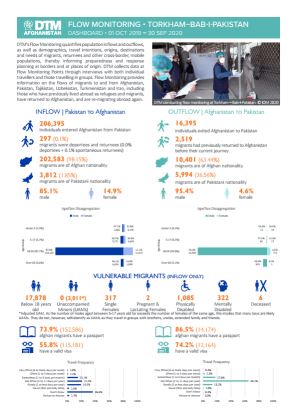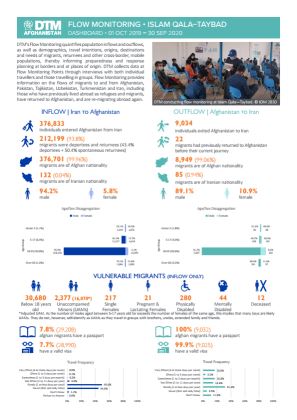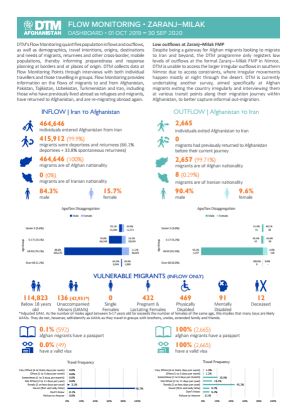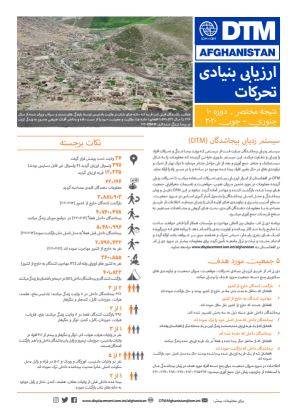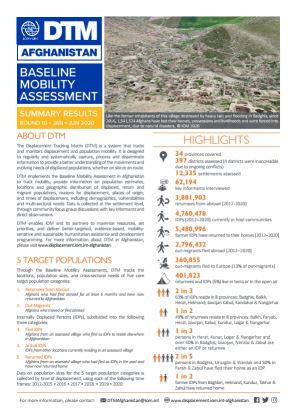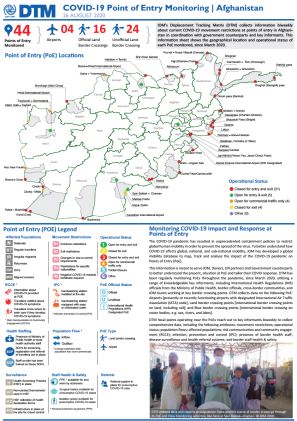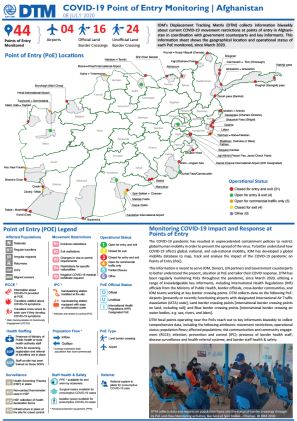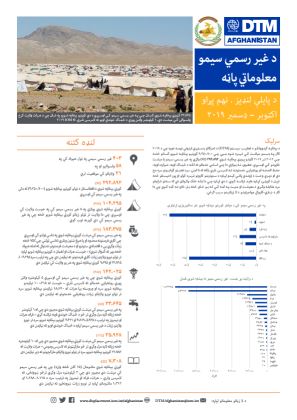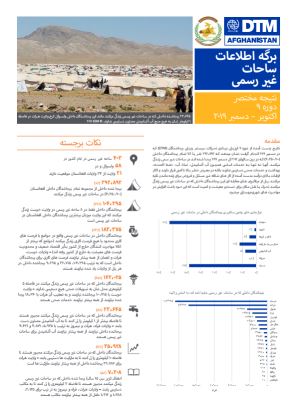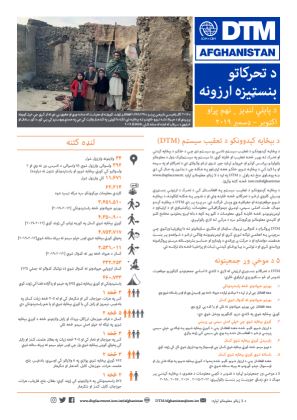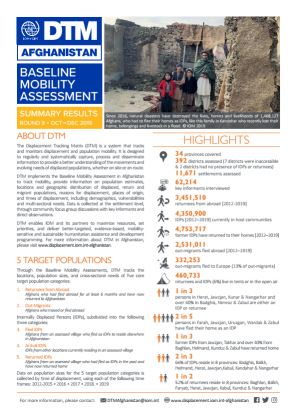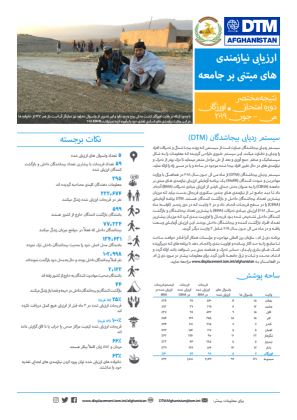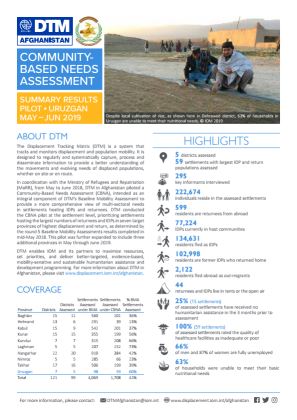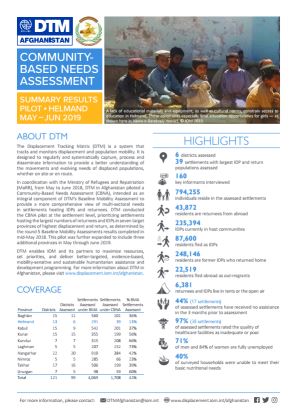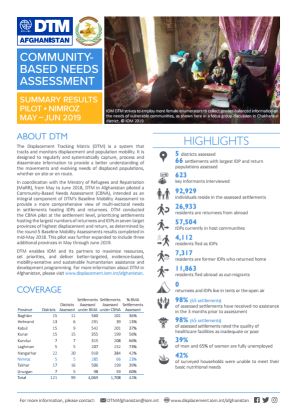-
Countries
-
Data and Analysis
-
Special Focus
-
Crisis Responses
Afghanistan
Afghanistan
IDPs tracked
Displacement Movements
4,187,000
IDMC 2023
Data collection round
About Afghanistan
The Displacement Tracking Matrix (DTM) is an information management system of tools and methodologies used to track and monitor displacement and population mobility. In Afghanistan, IOM activated the DTM programme in January 2017 in response to the substantial increase of Afghans returning home from neighbouring countries, as well as record levels of internal displacement. DTM in Afghanistan is designed to regularly and systematically capture, process and disseminate multi-layered information about the population sizes, locations, geographic distribution, movements, vulnerabilities, evolving multisectoral needs, and the drivers of migration of returnees, IDPs, migrants and mobile populations. DTM implements baseline mobility assessments, flow monitoring, registrations, and various migration surveys to provide an essential evidence base that enables decision-makers and humanitarian, reintegration and development partners to maximize resources and deliver efficient, better-targeted, mobility-sensitive and sustainable humanitarian; reintegration, community stabilization and development programming.
The value-added impact of DTM in Afghanistan is to inform action and results for people in need. DTM Afghanistan implements its activities at both the national and provincial levels. DTM works closely with other (IOM) programmes through referring identified populations in need of assistance at flow monitoring points to IOM’s Cross Border Return and Reintegration, Protection, Humanitarian Assistance, and Reintegration and Development (RADA) programmes. DTM Afghanistan also supports humanitarian partners and clusters, including WFP, FAO, UNHCR, IRC, DRC, NRC, and WHO, among many others, by providing emergency tracking updates in large-scale or sudden onset movements, such as emergency event tracking and drought response. Furthermore, stabilization and development actors, including IOM’s RADA programme, and the World Bank leverage DTM’s information to select priority communities and districts with higher concentrations of IDPs and returnees to receive reintegration and livelihoods assistance and improvements to core infrastructure and essential services. In support of health partners, including WHO, UNICEF, and the Humanitarian Health Cluster, DTM data informs the selection of priority, at-risk districts, border areas, communities, and health facilities in need of strengthened capacity, response, surveillance, and risk education for polio, TB, COVID-19, and other infectious diseases.
Contact
Modher ALHAMADANI
Senior Programme Coordinator - DTM
malhamadani@iom.int
DTM AFGHANISTAN
DTMAFGHANISTAN@iom.int
Current Donors
- Republic of Korea
- Norway
- CERF
- Canada
- Italy
- EU
- FCDO
Afghanistan — Flow Monitoring Dashboard :: Torkham—Bab-i-Pakistan (October 2019—September 2020)
This dashboard highlights key findings from DTM's Flow Monitoring implemented at the Torkham—Bab-i-Pakistan border crossing with Pakistan in Nangarhar province.
Afghanistan — Flow Monitoring Dashboard :: Islam Qala—Taybad (October 2019—September 2020)
This dashboard highlights key findings from DTM's Flow Monitoring implemented at the Islam Qala—Taybad border crossing with the Islamic Republic of Iran in Herat province.
Afghanistan — Flow Monitoring Dashboard :: Zaranj—Milak (October 2019—September 2020)
This dashboard highlights key findings from DTM's Flow Monitoring implemented at the Zaranj—Milak border crossing with the Islamic Republic of Iran in Nimroz province.
CBNA R10 — Afghanistan — Community-Based Needs Assessment: Summary Results (January—June 2020)
In January through June 2020, DTM implemented the Community-Based Needs Assessment (CBNA) at the settlement level, as an integral component of DTM's Baseline Mobility Assessment (BMA), providing a comprehensive overview of the evolving, multi-sectoral needs in settlements hosting IDPs and returne
Afghanistan — Baseline Mobility Assessment Summary Results (January—June 2020) [پښتو]
د بېځایه کېدونکوو د تعقیب سیسټم په افغانستان کې د تحرک د ارزونې بنسټیزې وسیلې کاروي ترڅو له تحرکاتو څخه څارنه وشي او د نفوس په هکله اټکلونه، د جبري بېځایه کېدنو موقعیتونه او جغرافیه وي وېش څرګند شي.
Afghanistan — Baseline Mobility Assessment Summary Results (January—June 2020)
In Afghanistan, DTM employs the Baseline Mobility Assessment tool, designed to track mobility, determine the population sizes, locations and geographic distribution of forcibly displaced, return and migrant populations, reasons for displacement, places of origin, and times of
Afghanistan — COVID-19 Impact on Points of Entry Report (26 August 2020)
The COVID-19 pandemic has resulted in unprecedented containment policies to restrict global human mobility in order to prevent the spread of the virus.
Afghanistan — COVID-19 Impact on Points of Entry Report (8 July 2020)
The COVID-19 pandemic has resulted in unprecedented containment policies to restrict global human mobility in order to prevent the spread of the virus.
Afghanistan — Informal Settlements Information Sheet (October — December 2019) [پښتو]
د بېځایه کېدوونکو د تعقیب سیسټم (DTM) د تحرکاتو بنسټیزې ارزونې نهمې دورې پایله چې د ۲۰۱۹ کال په ډسمبر میاشت کې ترسره شوه ښیي چې ۴٬۳۵۰٬۹۰۰ کورنیو بېځایه شویو کسانو څخه چې ۲۰۱۲ تر ۲۰۱۹ کلونو پورې بېځایه شوي ۲۹۲٬۸۹۲ (٪۷) وګړي په غیر رسمي سیمو یا مېشت ځایونو کې اوسېږي.
Afghanistan — Informal Settlements Information Sheet (October — December 2019) [دری]
طبق نتایج بدست آمده از دوره ۹ ارزیابی بنیادی تحرکات سیستم ردیابی بیجاشدگان (DTM) در ۳۱ دسمبر ۲۰۱۹ که در دسمبر ۲۰۱۹ انجام گرفت ۲۹۲٬۸۹۲ نفر یا ٪۷ تمام بیجاشدگان داخلی (۴٬۳۵۰٬۹۰۰) که در بین سالهای ۲۰۱۲ الی دسمبر ۲۰۱۹ بیجا شده اند در ساحات غیر سمی زندگی میکنند.
Afghanistan — Baseline Mobility Assessment Summary Results (October —December 2019)
As of 31 December 2019, 292,892 (7%) of the total 4,350,900 IDPs, displaced between January 2012 and December 2019, are living in informal settlements, according to results from round 9 of DTM’s Baseline Mobility Assessments conducted in December 2019.
Afghanistan — Baseline Mobility Assessment Summary Results (October—December 2019) [پښتو]
د بېځایه کېدونکوو د تعقیب سیسټم په افغانستان کې د تحرک د ارزونې بنسټیزې وسیلې کاروي ترڅو له تحرکاتو څخه څارنه وشي او د نفوس په هکله اټکلونه، د جبري بېځایه کېدنو موقعیتونه او جغرافیه وي وېش څرګند شي.
Afghanistan — Baseline Mobility Assessment Summary Results (October —December 2019)
In Afghanistan, DTM employs the Baseline Mobility Assessment tool, designed to track mobility, determine the population sizes, locations and geographic distribution of forcibly displaced, return and migrant populations, reasons for displacement, places of origin, and times of
Afghanistan — Survey on Drivers of Migration (REMAP 2019)
The key finding of this report is that push and pull factors, as well as the challenges Afghan potential migrants face daily at personal, household and community levels, revolve around a lack of livelihood options and insecurity.
افغانستان — ارزیابی نیازمندی های مبتنی بر جامعه: هلمند، دوره ۱ :: می— جون ۲۰۱۹
سیستم ردیابی بیجاشدگان (DTM) از ماه می الی جون سال ۲۰۱۹ در هماهنگی با وزارت مهاجرین و عودت کنندگان (MoRR) یک برنامه آزمایشی ارزیابی نیازمندی های مبتنی بر جامعه (CBNA) را به عنوان بخش جدایی ناپذیر از ارزیابی بنیادی تحرکات (BMA) در ولایت هلمند آنج
افغانستان — ارزیابی نیازمندی های مبتنی بر جامعه: نیمروز، دوره ۱ :: می— جون ۲۰۱۹
سیستم ردیابی بیجاشدگان (DTM) از ماه می الی جون سال ۲۰۱۹ در هماهنگی با وزارت مهاجرین و عودت کنندگان (MoRR) یک برنامه آزمایشی ارزیابی نیازمندی های مبتنی بر جامعه (CBNA) را به عنوان بخش جدایی ناپذیر از ارزیابی بنیادی تحرکات (BMA) در ولایت نیمروز آن
Afghanistan — Community-Based Needs Assessment: Uruzgan, Round 1 (May — June 2019)
In coordination with the Ministry of Refugees and Repatriation (MoRR), from May through June 2019, DTM in Afghanistan piloted a Community-Based Needs Assessment (CBNA) in Uruzgan, intended as an integral component of DTM's Baseline Mobility Assessment to provide a more comprehensive view of multi
Afghanistan — Community-Based Needs Assessment: Helmand, Round 1 (May — June 2019)
In coordination with the Ministry of Refugees and Repatriation (MoRR), from May through June 2019, DTM in Afghanistan piloted a Community-Based Needs Assessment (CBNA) in Helmand, intended as an integral component of DTM's Baseline Mobility Assessment to provide a more comprehensive view of multi
Afghanistan — Community-Based Needs Assessment: Nimroz, Round 1 (May — June 2019)
In coordination with the Ministry of Refugees and Repatriation (MoRR), from May through June 2019, DTM in Afghanistan piloted a Community-Based Needs Assessment (CBNA) in Nimroz, intended as an integral component of DTM's Baseline Mobility Assessment to provide a more comprehensive view of multi-
Afghanistan — Flow Monitoring Dashboard :: Iran + Pakistan (October 2019—September 2020)
DTM's Flow Monitoring quantifies population inflows and outflows, as well as demographics, travel intentions, origins, destinations and needs of migrants, returnees and other cross-border, mobile populations, thereby informing preparedness and response planning at borders and at places of origin.
Afghanistan — Flow Monitoring Dashboard :: Iran (October 2019—September 2020)
DTM's Flow Monitoring quantifies population inflows and outflows, as well as demographics, travel intentions, origins, destinations and needs of migrants, returnees and other cross-border, mobile populations, thereby informing preparedness and response planning at borders and at places of origin.
Pagination
Pagination
Pagination
- First page
- Previous page
- 1
- 2
- 3
- 4
- 5


